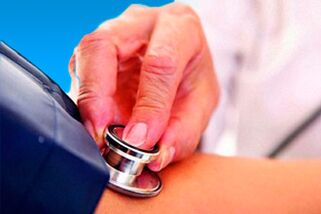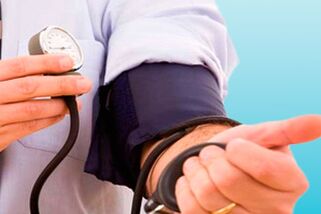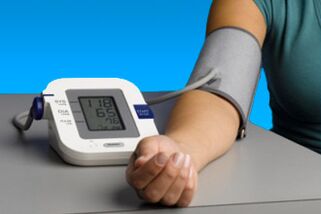
Violation of blood pressure can inspire failure of the entire organism. Although the disease cannot be completely cured, the course of the disease may make the patient less noticeable and problematic.
Michen Organ
Arterial hypertension is a chronic disease associated with increased internal pressure in the blood vessel wall. In this case, it is important to distinguish between rare situations when a person increases stress and the true manifestation of the disease. For various reasons, a time may be added and is usually not repeated as soon as possible. The reason may be a person's excitement, hormone failure or injury.
When asking what is arterial hypertension, it is necessary to deal with the term "hypertension". This is a temporary increase in blood pressure exceeding 140/90. However, hypertension in medicine is called a person's indicator of stable disease. They rarely fall below these numbers themselves.
The negative side of the disease is not only chronic hypertension in the cardiovascular system. In medicine, there are things like target organs. The essence of the problem is that increasing blood pressure can negatively affect many organs (heart, kidney, brain, and retina). The disease can have a negative impact on the whole body, but it will suffer first. Even the classification principles of the disease depend on which body it has a negative impact.
Disease stage
The various forms of the disease depend on the principle to be classified. They can depend on the origin, process, and blood pressure level. The easiest form of arterial hypertension is easiest because patients can find their own stress at home.
Like other diseases, the development of hypertension has multiple degrees and can only be aggravated without the necessary treatment. There are some norms that help determine the stage of the disease. After a stress measurement for one or two people, you cannot draw conclusions because this approach may provide incorrect indicators. If a person had taken certain medications or had a surge in mood before and no more emotions were a bad thing or a good thing, the indicators could change. This will not allow you to see the true nature of the patient's health.
Do not confuse high pressure with high pressure within the normal range with the manifestation of arterial hypertension. For the human body, pressure of 120/80 is considered normal, but pressure can also be classified as 129/84. Stress was considered to increase to 139/89 but was not classified as hypertension. Hypertension is considered to be stress over 140/90.
Table 1. High blood pressure and stress levels
| Arterial hypertension degree | index |
|---|---|
| specification | From 120/80 to 139/89 |
| 1 degree hypertension | From 140/90 to 159/99 |
| 2 degree hypertension | From 160/100 to 179/109 |
| 3 degrees of hypertension | From 180/110 and above |

In addition to the definition of "hypertension" based on the degree of development and the classification of the disease, there is a unit of primary and secondary hypertension. In this case, the main pathological development is a separate pathology, and no other problems in the human body are found. If we are talking about secondary hypertension, it will be the result of existing diseases in the human body.
First degree
It is considered a mild form of disease, with blood pressure not exceeding 160/100, and the onset has no major consequences. First-grade arterial hypertension is characterized by spastic diseases that occur during heart work. A period of worsening is almost impossible to be rare, but patients are easily suffering from the patient due to the smaller manifestations of the disease and the chronic course of the disease. The aggravation alternates with normal indicators, during which time the patient feels no symptoms of the disease.
To fully assess the situation, it is necessary to use the artery volume several times a day for pressure measurements. Usually, this is done three times a day without emotional outbreaks or other reasons that may affect changes in blood pressure.
First-grade arterial hypertension has its own symptoms and patients usually cannot take it seriously. This disease can be manifested as a headache on the left side of the sternum, a rapid heartbeat or pain. Usually, patients rarely have grade 1 hypertension characterized by symptoms that confuses the patient.
But even a little bit of high blood pressure can have its own complications, which are full of serious diseases in the human body. this:
- The brain is slightly naked;
- Myocardial hypertrophy;
- Kidney sclerosis.
Assuming that grade 1 arterial hypertension can be treated with medication, the traceless arterial hypertension is misunderstood. It can be said that patients with first-grade hypertension are at risk of complications. Statistics show 15% of this probability.
When a patient is diagnosed with first degree of hypertension, the situation is as follows: High pressure can be triggered by a narrow gap in the blood vessel, resulting in insufficient nutrition in human tissues. Necrosis is achieved in the absence of normal amounts of nutrients and oxygen in the cells. Initially, this process is not obvious, but over time, certain organs in the patient's body, not just certain cells, may occur over time. Ischemic stroke caused by lack of treatment.
If the patient has high blood pressure, even grade 1 high blood pressure can create a high risk of heart problems.
The change in the indicator of the larger orientation gives the extra load on the heart, trying to push the blood through the narrow gap in the container, which is overwhelming. Everyone knows that with the extra load, the muscles start to grow, which also happens in the heart tissue. Level 1 risk of hypertension seems to reduce the risk because the heart can draw blood more effectively, but this is not entirely true. Cardiomyopathy can squeeze a ship at close range and even cause death.
Second degree

Under second degree arterial hypertension, the patient's level will reach 180/110 mm Hg. In this case, the patient's patients are much greater than the primary hypertension and have a lower risk of complications.
The second degree of hypertension is characterized by the fact that the stress rarely occurs normally, which can be reduced and increased, but cannot reach the allowable limit. Typically, primary hypertension has the risk of entering the same disease for the second degree, and the occurrence of benign or malignant arterial hypertension can then be determined. To clarify what kind of arterial hypertension, what it brings and the risks that arise help pathological development.
In patients, vascular deficiency, head pulsation, hyperemia, visual visual problems and hypertension crisis are added to already familiar symptoms. The problem with the latter is that stress can change dramatically by 59 units, which negatively affects the patient's body. In the second hypertension, complications are possible:
- Cerebral thrombosis;
- aortic aneurysm;
- atherosclerosis;
- Angina pectoris;
- Brain disease.
The particularity of the degree of development of hypertension is that failure of the target organ occurs. In patients with this diagnosis, one of the organs may bleed. This is due to the fact that under later arterial hypertension, the blood vessels lose their former elasticity and can easily collapse. There is also a serious risk that blood clots have been formed on the walls of blood vessels, and these cavity have been reduced.
Patients may suffer from disability due to serious problems that may occur in second arterial hypertension. They usually give three groups. But this does not mean that it is sufficient to make the patient measure its pressure multiple times and indicate that it exceeds the permitted norm. The Commission takes into account the complications of the disease context and collects information about hypertension and on the working conditions of the patients – only after this can we talk about getting cash benefits.
The Commission takes into account the complications of the disease context and collects information about hypertension and on the working conditions of the patients – only after this can we talk about getting cash benefits.
The paradox of this situation is that some patients try to get this help with the initial symptoms, while others instead hide their illness. In most cases, this is done by employees who can be fired due to working conditions (this will have more sick leave, and an additional annual leave). But we cannot forget that in secondary hypertension, additional load can have serious consequences, which can rapidly exacerbate the disease.
It is worth noting that there may be special circumstances in secondary arterial hypertension. When it comes to malignant pathology, the committee can assign 2 groups of persons with disabilities. Males over 60 years old, women over 55 years old, and patients with irreversible defects have found life disability. This means there is no need to confirm identity through the committee every year.
The third degree
Through a person's stress, the degree of the disease can be determined. When the indicator begins to reach extremely high rates - starting at 180/110 mm Hg, the patient is diagnosed with a third severity of hypertension. In this case, these complications are very serious and most of them do not provide medical services in a timely manner and may lead to death. This can be stroke, heart asthma, myocardial infarction, renal failure and other diseases.
The severity of this degree was assessed and a group of disabilities was assigned to the patients. Assess the level of risk of disease development, patients must recover without failure. There is no need to talk about this level of treatment, but this approach will help avoid premature death.
The fourth level has the concept of hypertension. In this case, it is difficult for a person to help because he is actually on the verge of death. Medications help reduce symptoms and greatly reduce stress levels. Hypersonic crises are obvious and very frequent.
Level of risk
Usually, when diagnosing a patient, the degree of disease and risk is indicated. This indicator may affect age, gender, obesity, bad habits and other factors.
There are four risks. The best hypertension considering the primary risk 1 is that the probability of developing side disease is less than 15%. Grade 1 (risk 2) arterial hypertension is one of the most popular diagnoses. This is due to the fact that few patients live this way of life, which does not complicate the disease in any way. When primary arterial hypertension is diagnosed (risk 2), the probability of complications ranges from 15% to 20%.
The risk of 3 degrees is 20-30% of the chance of disease development. It is called high. When the probability of pathology development is more than 30%, there are also 4 degrees. In the absence of patient lifestyle changes, predictives of all levels of risk over the next 10 years.
Based on the lesions in the patient's internal organs, the doctor said the stage and extent of hypertension caused by the indicators. Determine which organs are damaged is the stage of the disease.
In fact, there is no indicator in the first phase of the disease because it only increases stress and the human organs are not damaged. With the first stage of hypertension, patients will have optimistic predictions about the future.
During the two stages of the disease, the first sign of plasma was found, with plaques appearing and increased creatinine. All changes occurring in the internal organs are usually not severe, and with proper treatment, complications can be prevented.
Unlike the second stage, the third stage is characterized by a specific disease, not just partial change. This is obvious arterial hypertension, which means that in patients, the risk of metastatic myocardial infarction, stroke, heart and renal failure, and other characteristic diseases is increased several times.
Characteristics of the disease

Arterial hypertension is common around the world and is most common in highly developed countries. First, this is because active life means communication with a large number of people, which requires different emotions, whether bad or good, which can lead to increasing stress.
For many people, answering questions is not even difficult? The prevalence of the disease makes this pathology called the plague of the 21st century. There is arterial hypertension syndrome, which is chronic vascular deficiency, the same hypertension. Violations in vascular work that cause arterial hypertension syndrome.
Pregnant arterial hypertension is extremely negative for women. The emergence of this pathology is related to pregnancy, and taking most medications during this period is contraindicated.
At the same time, lack of treatment can have extremely negative consequences. Statistics show that pregnancy arterial hypertension is a cause of one-third of the fatal outcomes of mothers during delivery, and it can also cause death from fetal or premature birth.
In addition to the fact that patients should be aware of the symptoms of hypertension and the fact that it is necessary to contact the hospital in time, because it is much easier to treat the disease in the first stage. It is necessary to consult with doctors who are increasing the dose or participating in other medications. Self-assays can aggravate the disease.























